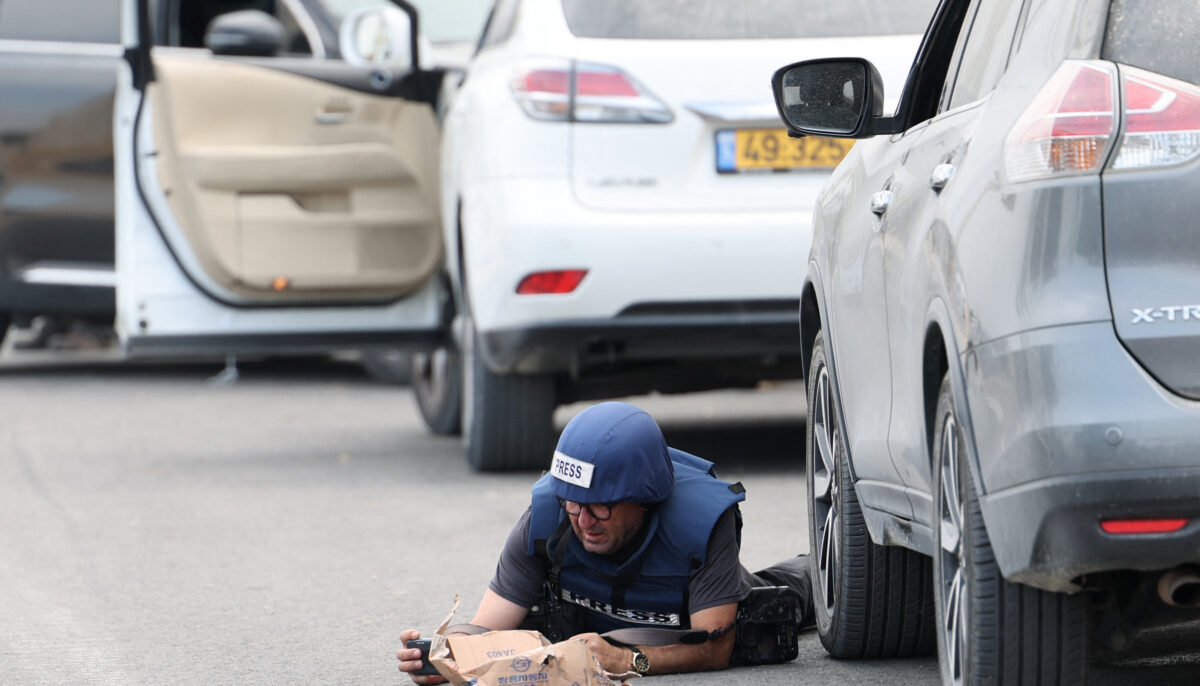Operation Al-Aqsa Flood, during which resistance fighters stormed Zionist settlements around Gaza in a secretly planned and flawlessly executed attack, along with the military media coverage of the operation, constituted a major security, digital, and intelligence failure for “Israel” – which is ranked among the world’s leading countries in terms of military technology.
Israel’s colonialist regime has always used technology and digital tools to censor and oppress Palestinians and violate their right to privacy, freedom of expression, and safe access to the internet. This article discusses Israel’s most recent acts of aggression which have sought to destroy Palestinians’ digital infrastructure and decimate their human and material resources, as part of its humanitarian and digital violations which long predate Al-Aqsa Flood.
What the Telecom Shutdown Means for Gaza
On October 9, the Israeli occupation’s warplanes destroyed the headquarters of the Palestine Telecommunications Company (Paltel), along with 86 of the company’s towers, in a series of violent airstrikes that targeted Al-Rimal neighborhood in central Gaza. The assault resulted in the death of 26 civilians, including eight children. The airstrikes also restricted access to the internet and telecom networks and even led to a complete shutdown of services in some areas, according to Internet Outage Detection & Analysis (IODA). A Paltel official also stated that technical teams are facing immense challenges.
Palestinians in Gaza now have very limited internet access, allowing them at best to send and receive some text messages. Wireless internet providers have announced that they are “unable to continue providing services due to the bombing of servers.”
Despite the fact that the Oslo II Accord, also known as the Interim Agreement on the West Bank and the Gaza Strip, signed in September 1995, grants Palestinians the right to have independent telecom and internet infrastructure, most telecom services in Gaza, which still rely on 2G networks, are subject to direct censorship by occupation forces. The operations of Palestinian telecom and internet companies are linked to Israel’s central telecom network infrastructure in occupied Jaffa and Haifa because Palestinian companies do not have direct links to submarine cables amid the lack of sovereignty over the occupied Palestinian shores.
By having access to the control units of Palestinian networks, occupation forces can penetrate the Palestinian telecom and internet system, collect information, and monitor everything that flows through it, especially in times of war. This censorship is not limited to intimidating Palestinians and sending them threatening messages such as “You have been classified as a participant in hostile actions and will be neutralized.” Rather, “the internet in the Palestinian territories has become a tool used as part of the Israeli occupation’s daily military practices, just like arrests, raids and the expansion of settlements, and it is subject to censorship, monitoring, information gathering and eavesdropping,” according to a study by Sada Social.
Historically, the Israeli occupation has always targeted telecom networks in Gaza. It bombed telecom and internet towers during the ground invasion of Gaza in 2008, and in 2011 Israeli bulldozers cut a series of wires buried 8-20 metres underground and providing signal to towers in Gaza. The occupation has also prevented the reconstruction of Gaza’s destroyed digital infrastructure by banning the entry of equipment through border crossings since 2014. In 2018, an Israeli unit infiltrated Gaza to plant an eavesdropping system to tap into the internal communications network of Al-Qassam Brigades developed by the resistance using special landlines in 2009. This network was used for the first time in 2012 to ensure communication between resistance fighters and field commanders.
Internet infrastructure plays a vital role in managing military confrontations, keeping people up to date during crises and ensuring access to all types of information, services and support. Every time the occupation bombs or disrupts telecom towers in Gaza, which are operating at full capacity to provide the most basic rights to people, the city suffers from a complete blackout and becomes isolated from its geographical surroundings, enabling the occupation to conceal its crimes. One day after the bombing of Al-Rimal neighborhood, Israeli ministers announced that they will cut off basic supplies of electricity, water, fuel and food to Gaza. This makes the telecom and internet shutdown seem less important, especially when more than two million people are under a complete siege.
The Central Role of the Media War
When military footage was released documenting the operation carried out by the resistance, Israeli media outlets were at a loss, not knowing whether to share these videos and express their discontent with the Israeli government, demand brutal retaliation or play the victim and give justifications to the bombing of Gaza. The videos shared by the resistance set the stage for local and western media depictions this time and were the main source of information about the storming of military bases, the number of Israeli deaths and the pictures of some detainees. This forced the occupation to admit the extent of its losses after years of monopolizing information and archives and spreading misinformation in the media.
The May 2021 uprising played a key role in determining the importance of both traditional and modern media in formulating the narrative. When major Western media outlets justified the forced displacement of Palestinians and their removal from their homes, hashtags, livestreams by Arab celebrities, and the live coverage of crimes committed by armed settlers showed the world the Palestinian narrative about the Sheikh Jarrah neighborhood. At the time, Palestinian activists faced immense digital restrictions by social media platforms. The Arab Center for Media Development detected more than 750 violations against Palestinian content, mainly on Facebook and Instagram, adding that Facebook responded to 81% of Israeli requests to remove posts, most of which were related to Palestine.
Marwa Fatafta from Access Now said that social media platforms’ policies are not just a form of censorship but rather digital oppression. In reality, the Palestinian narrative and the voices of those documenting war crimes are being suppressed. The restriction of Palestinian content includes blocking livestreams, removing posts, and suspending accounts.
In October 2021, The Intercept published a report that revealed Facebook’s secret blacklist for the first time. The list includes thousands of “dangerous individuals and organizations,” including 55 Palestinian organizations, figures, and associations. Facebook’s algorithms disrupt the content published by these accounts and automatically block posts including certain terms like martyr, Qassam, resistance, and Ayyash (in reference to the martyr Yahya Ayyash).
During the Al-Aqsa Flood, Palestinian Observatory of Digital Rights Violations (7or) detected at least 140 cases of removal and restriction and 222 cases of harmful content. The Observatory also urged social media users to report violations, which include hate speech, incitement and racism by Israeli accounts calling for attacks against Palestinians. Nadim Nashif, Executive Director of the Arab Center for Social Media Advancement (7amleh), explains that reporting violations to the “7or” platform will enable it to contact and pressure social media companies. “X” (previously Twitter) recently updated its policies to remove all Hamas-affiliated accounts or those promoting violent speech and hateful conduct “to try and prevent terrorist content from being distributed online,” according to a statement published by the company.
Nashif adds that it is important not to underestimate the impact of the incitement and hateful content that encouraged settlers to carry out several assaults against the residents of the village of Huwara last February, harming them and damaging their properties. Therefore, the smart use of social media platforms is the optimal way to ensure proper coverage. This can be done by: 1) verifying the accuracy of information to avoid spreading misinformation disseminated by Israeli accounts and electronic armies in these exceptional circumstances; and 2) being mindful of the security aspect by refraining from sharing any information or videos that could reveal sensitive security details to the occupation, thereby facilitating the targeting of resistance fighters.
Gaza Mourns Nine of its Journalists
Al-Jazeera’s media office in Gaza documented the killing of nine journalists due to the recent Israeli airstrikes: Ibrahim Lafi, Mohammad Jarghoun, Mohammad Al-Salhi, Asaad Shamlikh, Saeed Al-Taweel, Mohammad Subh Abu Rizk, Hisham Alnwajha, Mohammad Abu Matar and Salam Mema. The media office also stated that more than ten journalists sustained wounds of varying severity, while two others – Nidal Al-Wahidi and Haytham Abdul Wahed – could not be contacted. In addition, the houses of Rami Al-Sharafi and Bassel Khairuddin were bombed and destroyed, and those of dozens of other journalists were partially damaged.
As of the time of writing this article, 23 journalists have been killed by Israeli airstrikes. Journalists’ families are now also being targeted in a vengeful strategy to punish those covering the war. Wael Dahdouh, prominent Al-Jazeera Arabic’s bureau chief in Gaza, walked into a morgue to find the dead bodies of his wife, his 15 year-old son, his seven-year old daughter, and his grandson who were killed by an Israeli air raid on October 25, 2023. Photojournalist and filmmaker Roshdi Sarraj was killed by an Israeli air strike on his family home on October 22, 2023. One of Sarraj’s last tweets succinctly describe the harrowing reality of reporting under Israel’s genocide: “A lack of media coverage from Gaza…due to the killing of more than 12 journalists, the bombing, the blackout of electricity and the internet. However, we are still trying to withstand and continue coverage so the world can see the Israeli crimes in Gaza.”
Israeli warplanes also inflicted severe damage on the headquarters of dozens of media outlets, some of which were completely destroyed due to the airstrikes, including the Palestine and Watan towers. In fact, more than 40 media headquarters were damaged. When mourning the journalists killed by “Israel,” Palestinians carried their blood-soaked press vests and cameras, which bore witness to the brutality of the Israeli occupation that intentionally targeted them to prevent them from revealing the truth and documenting its crimes.
Between 2000 and 2022, “Israel” killed 55 journalists, and countless others lost their jobs, equipment or limbs due to the bombardment.
In 2012, Israel’s assault on Gaza killed three journalists and wounded nine others in a direct attack against them and their offices in Al-Sahafa (Arabic for “press”) street. At the time, a military official from the Israeli army told “Voice of Israel” radio that they intentionally targeted journalists, stating verbatim that “the bombing targeted the broadcasting antennas of some TV stations,” according to a report by the Euro-Med Human Rights Monitor.
More recently, a detailed report by the Committee to Protect Journalists (CPJ) identified the main patterns of journalist killings by the Israeli military, which are as follows: discounting evidence and witness claims; failing to respect press insignia; pushing false narratives to media reporting; and accusing journalists of terrorism. The report also mentioned that the degree to which “Israel” investigates, or claims to investigate, journalist killings appears to be related to external pressure. Israeli officials, including those tasked with investigating killings, often make public statements exonerating soldiers before probes are complete. In addition, they delay investigations for months or even years amid a lack of transparency and information about progress.
All these violations are committed without any international accountability, leading to a more dangerous environment for media coverage as journalists fear for their lives while performing their humanitarian duties. Journalists are a key factor in disseminating the Palestinian narrative. They are the human element sustaining Palestinians’ digital infrastructure, making their voices heard and documenting the occupation’s war crimes. The Israeli assaults against Palestinians’ most basic rights, which are far more serious to be referred to as mere “violations,” are still ongoing with the brutal bombardment of Gaza and the United States’ overt support of the occupation, leading to more and more martyrs with each passing day.



